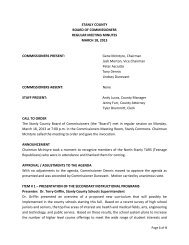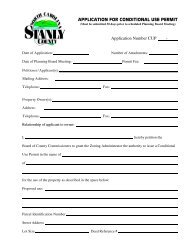Land Use Plan – 2002 - Stanly County, North Carolina
Land Use Plan – 2002 - Stanly County, North Carolina
Land Use Plan – 2002 - Stanly County, North Carolina
You also want an ePaper? Increase the reach of your titles
YUMPU automatically turns print PDFs into web optimized ePapers that Google loves.
STANLY COUNTY<br />
examined include the management of driveway separation distances and the use of right-in and<br />
right-outs. Crossovers and lights should be kept to a minimum since statistics indicate accidents<br />
and congestion increase when traffic signals are installed.<br />
Roadways Issues<br />
Bicycle Routes<br />
A large number of roadway issues have been raised through this point in the <strong>Land</strong> <strong>Use</strong> <strong>Plan</strong><br />
development process. The following list was developed based on technical interviews with<br />
transportation planners, county officials, and the <strong>Land</strong> <strong>Use</strong> <strong>Plan</strong> Steering Committee. As the<br />
planning process continues, information obtained from public meetings and other sources will be<br />
integrated into this list.<br />
Improved access to the remainder of central <strong>North</strong> <strong>Carolina</strong> has been identified as a primary<br />
concern for the long-range well being of the county. Currently there are no limited-access<br />
highways in <strong>Stanly</strong> <strong>County</strong> and only two sections of U.S. 52—one four-lane section in<br />
Albemarle and a five-lane section in Richfield—containing more than three lanes of traffic.<br />
The lack of better access to regional markets has been identified as a significant hindrance<br />
to economic development efforts in the county.<br />
<strong>Stanly</strong> <strong>County</strong> needs to plan for future roadway improvements now in order for them to be<br />
added to NCDOT’s TIP. Presently there is a seven-year waiting period between the<br />
placement of a project on the TIP and actual construction. <strong>Stanly</strong> <strong>County</strong> should continue<br />
with long-range transportation planning efforts to ensure that road projects will be added to<br />
the state TIP.<br />
The overall circulation system in <strong>Stanly</strong> <strong>County</strong> needs to be improved. Generally there is a<br />
lack of a north-south connections especially in the western part of the <strong>County</strong>. Another<br />
connection from NC 24/27 to NC 73 is needed. Further, the secondary and tertiary road<br />
system will require improvement as development occurs.<br />
The placement of future schools in the county needs to be coordinated with long-range<br />
transportation plans in order to identify ideal locations relative to traffic flow. Interior campus<br />
circulation plans that allow for easy drop-off and pick-up and that limit traffic backups and<br />
congestion should also be examined.<br />
Industrial growth and development needs to be channeled to locations that support the truck<br />
traffic it will generate.<br />
The widening of NC 73 to four lanes needs to be examined. Currently this project is on the<br />
needs list for the TIP but is not funded. This improvement would greatly improve access<br />
from west-central <strong>Stanly</strong> <strong>County</strong> and Albemarle to Interstate 85, Concord, and Kannapolis.<br />
Kendalls Church Road, which provides access to the cotton gin in the Millingport area, is<br />
inadequately-sized for tractor-trailers that serve the gin. NCDOT recognizes the problem but<br />
the cost in order to remedy the situation is large relative to other needs in the county.<br />
Congestion was also brought up as an issue at U.S. 52 at <strong>North</strong> <strong>Stanly</strong> High School where<br />
high school students are dismissed and shift changes at nearby industrial businesses occur<br />
at the same time.<br />
NCDOT has identified a 187-mile bikeway system in <strong>Stanly</strong> <strong>County</strong> consisting of bike routes<br />
along existing roads. The system is illustrated in Figure 4-3. Table 4-2 provides a summary<br />
description of each route.<br />
<strong>Land</strong> <strong>Use</strong> <strong>Plan</strong> 4-7 6/02






